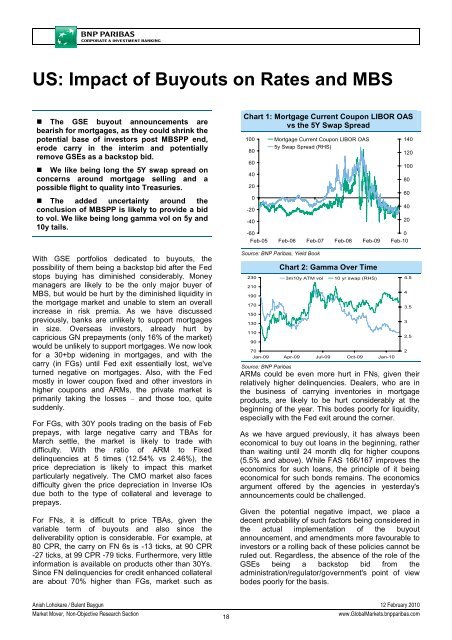Market Mover - BNP PARIBAS - Investment Services India
Market Mover - BNP PARIBAS - Investment Services India
Market Mover - BNP PARIBAS - Investment Services India
Create successful ePaper yourself
Turn your PDF publications into a flip-book with our unique Google optimized e-Paper software.
US: Impact of Buyouts on Rates and MBS<br />
• The GSE buyout announcements are<br />
bearish for mortgages, as they could shrink the<br />
potential base of investors post MBSPP end,<br />
erode carry in the interim and potentially<br />
remove GSEs as a backstop bid.<br />
• We like being long the 5Y swap spread on<br />
concerns around mortgage selling and a<br />
possible flight to quality into Treasuries.<br />
• The added uncertainty around the<br />
conclusion of MBSPP is likely to provide a bid<br />
to vol. We like being long gamma vol on 5y and<br />
10y tails.<br />
With GSE portfolios dedicated to buyouts, the<br />
possibility of them being a backstop bid after the Fed<br />
stops buying has diminished considerably. Money<br />
managers are likely to be the only major buyer of<br />
MBS, but would be hurt by the diminished liquidity in<br />
the mortgage market and unable to stem an overall<br />
increase in risk premia. As we have discussed<br />
previously, banks are unlikely to support mortgages<br />
in size. Overseas investors, already hurt by<br />
capricious GN prepayments (only 16% of the market)<br />
would be unlikely to support mortgages. We now look<br />
for a 30+bp widening in mortgages, and with the<br />
carry (in FGs) until Fed exit essentially lost, we've<br />
turned negative on mortgages. Also, with the Fed<br />
mostly in lower coupon fixed and other investors in<br />
higher coupons and ARMs, the private market is<br />
primarily taking the losses – and those too, quite<br />
suddenly.<br />
For FGs, with 30Y pools trading on the basis of Feb<br />
prepays, with large negative carry and TBAs for<br />
March settle, the market is likely to trade with<br />
difficulty. With the ratio of ARM to Fixed<br />
delinquencies at 5 times (12.54% vs 2.46%), the<br />
price depreciation is likely to impact this market<br />
particularly negatively. The CMO market also faces<br />
difficulty given the price depreciation in Inverse IOs<br />
due both to the type of collateral and leverage to<br />
prepays.<br />
For FNs, it is difficult to price TBAs, given the<br />
variable term of buyouts and also since the<br />
deliverability option is considerable. For example, at<br />
80 CPR, the carry on FN 6s is -13 ticks, at 90 CPR<br />
-27 ticks, at 99 CPR -79 ticks. Furthermore, very little<br />
information is available on products other than 30Ys.<br />
Since FN delinquencies for credit enhanced collateral<br />
are about 70% higher than FGs, market such as<br />
Chart 1: Mortgage Current Coupon LIBOR OAS<br />
vs the 5Y Swap Spread<br />
100<br />
80<br />
60<br />
40<br />
20<br />
0<br />
-20<br />
-40<br />
Mortgage Current Coupon LIBOR OAS<br />
5y Swap Spread (RHS)<br />
-60<br />
0<br />
Feb-05 Feb-06 Feb-07 Feb-08 Feb-09 Feb-10<br />
Source: <strong>BNP</strong> Paribas, Yield Book<br />
230<br />
210<br />
190<br />
170<br />
150<br />
130<br />
110<br />
90<br />
Chart 2: Gamma Over Time<br />
70<br />
Jan-09 Apr-09 Jul-09 Oct-09 Jan-10<br />
Source: <strong>BNP</strong> Paribas<br />
3m10y ATM vol<br />
10 yr swap (RHS)<br />
140<br />
120<br />
100<br />
ARMs could be even more hurt in FNs, given their<br />
relatively higher delinquencies. Dealers, who are in<br />
the business of carrying inventories in mortgage<br />
products, are likely to be hurt considerably at the<br />
beginning of the year. This bodes poorly for liquidity,<br />
especially with the Fed exit around the corner.<br />
As we have argued previously, it has always been<br />
economical to buy out loans in the beginning, rather<br />
than waiting until 24 month dlq for higher coupons<br />
(5.5% and above). While FAS 166/167 improves the<br />
economics for such loans, the principle of it being<br />
economical for such bonds remains. The economics<br />
argument offered by the agencies in yesterday's<br />
announcements could be challenged.<br />
Given the potential negative impact, we place a<br />
decent probability of such factors being considered in<br />
the actual implementation of the buyout<br />
announcement, and amendments more favourable to<br />
investors or a rolling back of these policies cannot be<br />
ruled out. Regardless, the absence of the role of the<br />
GSEs being a backstop bid from the<br />
administration/regulator/government's point of view<br />
bodes poorly for the basis.<br />
80<br />
60<br />
40<br />
20<br />
4.5<br />
4<br />
3.5<br />
3<br />
2.5<br />
2<br />
Anish Lohokare / Bulent Baygun 12 February 2010<br />
<strong>Market</strong> <strong>Mover</strong>, Non-Objective Research Section<br />
18<br />
www.Global<strong>Market</strong>s.bnpparibas.com
















